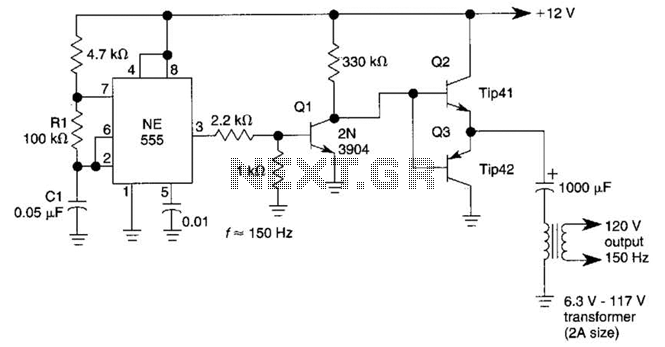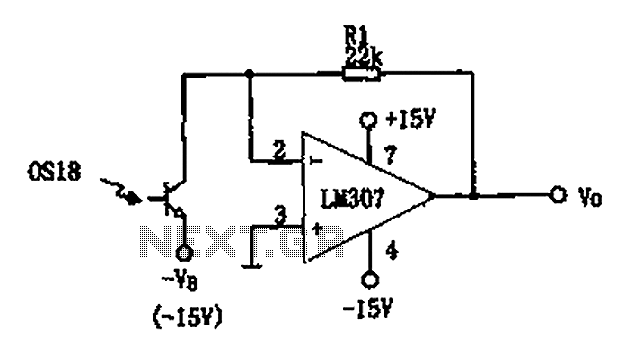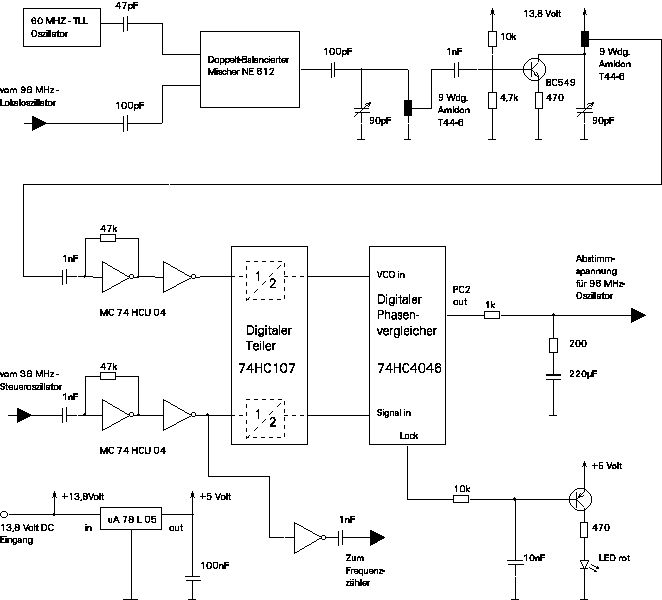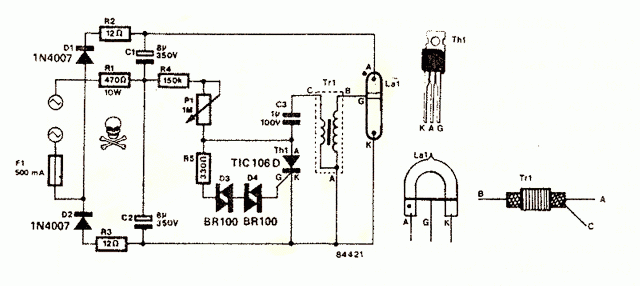
Proximity detector electronic project circuit design
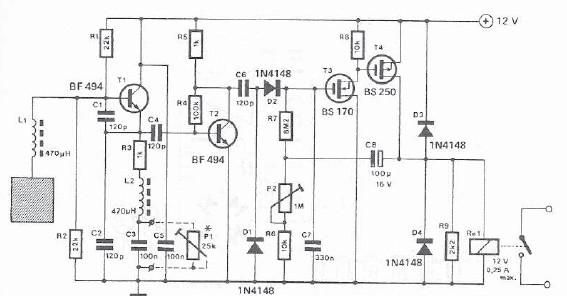
A simple proximity detector can be created using this electronic circuit. This circuit responds to the presence of a conductive object within a specific range. The sensitivity of the circuit can be adjusted with potentiometer P1 to achieve the desired detection distance. The circuit primarily consists of a monostable oscillator and a tipping stage. The oscillator is constructed using transistor T1, which ensures that the oscillator frequency remains stable due to the capacitance of the transistor being in parallel with relatively large capacitors C1 and C2 in the oscillating circuit. The surface acts as a sensor for the oscillator circuit's capacitance, which may be small compared to C1 and C2. In this configuration, the oscillator operates at approximately 1 MHz. The high-frequency signal is amplified and subsequently rectified, producing a control pulse for the monostable tipping stage comprised of transistors T3 and T4. By utilizing VFETs, it is possible to control the relay switching through the tipping stage. The switching time can be adjusted using potentiometer P2.
The proximity detector circuit operates on the principle of capacitance variation caused by the presence of conductive objects. The monostable oscillator, formed by transistor T1, generates a high-frequency signal, which is influenced by the capacitance of nearby conductive objects. The capacitors C1 and C2 are selected to ensure stable oscillation frequencies, typically around 1 MHz, allowing for reliable detection.
When a conductive object enters the detection field, it alters the effective capacitance seen by the oscillator, leading to a change in frequency. This change is detected and amplified, resulting in a high-frequency signal that is subsequently rectified. The rectified signal serves as a control pulse for the tipping stage, which is composed of transistors T3 and T4. This stage is responsible for activating the relay, which can control external devices or systems based on the proximity detection.
The use of VFETs (Vertical Field Effect Transistors) in the tipping stage allows for efficient control of the relay. VFETs provide advantages such as high efficiency and fast switching times, making them suitable for applications requiring rapid response. The switching time can be fine-tuned using potentiometer P2, allowing the user to adjust the response time of the relay activation based on specific application requirements.
Overall, this proximity detector circuit provides a straightforward and effective solution for detecting the presence of conductive objects, with adjustable sensitivity and reliable performance. It is applicable in various fields, including automation, security systems, and industrial applications, where non-contact detection is essential.A very simple proximity detector can be made using this electronic scheme. This electronic circuit reacts to the presence of a conductive object within a particular field. Circuit sensitivity can be adjusted with potentiometer P1 for the desired distance. The electronic circuit consists essentially of a monostable oscillator and a tipping stage. O scillator is built with transistor T1. This is why a flap that oscillator frequency is particularly stable, because the capacity of the transistor is in parallel with relatively large capacities C1 and C2 of the oscillating circuit. Surface acts as a sensor oscillator circuit capacity of, capacity may be small in comparison with C1 and C2.
in this configuration, the oscillator operates at about 1 MHz. High frequency signal is amplified and eventually rectified. In this way receives a control pulse to monostable tipping stage consisting of T3 and T4. By using VFET`s possible to order the relay switching by tipping stage. Switching time is determined by adjusting potentiometer P2. 🔗 External reference
The proximity detector circuit operates on the principle of capacitance variation caused by the presence of conductive objects. The monostable oscillator, formed by transistor T1, generates a high-frequency signal, which is influenced by the capacitance of nearby conductive objects. The capacitors C1 and C2 are selected to ensure stable oscillation frequencies, typically around 1 MHz, allowing for reliable detection.
When a conductive object enters the detection field, it alters the effective capacitance seen by the oscillator, leading to a change in frequency. This change is detected and amplified, resulting in a high-frequency signal that is subsequently rectified. The rectified signal serves as a control pulse for the tipping stage, which is composed of transistors T3 and T4. This stage is responsible for activating the relay, which can control external devices or systems based on the proximity detection.
The use of VFETs (Vertical Field Effect Transistors) in the tipping stage allows for efficient control of the relay. VFETs provide advantages such as high efficiency and fast switching times, making them suitable for applications requiring rapid response. The switching time can be fine-tuned using potentiometer P2, allowing the user to adjust the response time of the relay activation based on specific application requirements.
Overall, this proximity detector circuit provides a straightforward and effective solution for detecting the presence of conductive objects, with adjustable sensitivity and reliable performance. It is applicable in various fields, including automation, security systems, and industrial applications, where non-contact detection is essential.A very simple proximity detector can be made using this electronic scheme. This electronic circuit reacts to the presence of a conductive object within a particular field. Circuit sensitivity can be adjusted with potentiometer P1 for the desired distance. The electronic circuit consists essentially of a monostable oscillator and a tipping stage. O scillator is built with transistor T1. This is why a flap that oscillator frequency is particularly stable, because the capacity of the transistor is in parallel with relatively large capacities C1 and C2 of the oscillating circuit. Surface acts as a sensor oscillator circuit capacity of, capacity may be small in comparison with C1 and C2.
in this configuration, the oscillator operates at about 1 MHz. High frequency signal is amplified and eventually rectified. In this way receives a control pulse to monostable tipping stage consisting of T3 and T4. By using VFET`s possible to order the relay switching by tipping stage. Switching time is determined by adjusting potentiometer P2. 🔗 External reference

